Feng Shui your layout with these Chinese restaurant tips - Chinese Restaurant Interior Design Ideas
Feng Shui Your Layout With These Chinese Restaurant Tips
From recent statistics, over forty-thousand restaurants serve Chinese food in the US. Chinese cuisine has, over the years, become part of the American food. With all the numbers in this industry, being the owner of a Chinese establishment may not feel like you’re such a unique entity. However—don’t just be a statistic.

In this guide, we’re going to help you make your Chinese restaurant layout stand out from the crowd with unique design ideas and layouts that will make your establishment something to remember.
The main goal of the atmosphere of a layout isn’t only to make the customers feel welcome—you also want to give them a memorable experience they’ll definitely want to come back to.
When it comes to various cities all throughout the country, San Francisco and New York are home to Chinese restaurants that serve food with the Chinese-American style to even help assimilate the culture to suit the American palate.
Although this might mean a booming business, it’s possible that it takes away from the tradition and authentic form of food eaten and found in China.
The switch began as early as the 20th century when eateries and groceries that offered genuine Chinese food started to make Chinese-American food. This style of the food imitated the Southeastern China cuisines.

However, if you want to go above and beyond offering just cheap and tasty meals fro a change—and instead offer a completely transformed atmosphere, as well as an authentic, Chinese-eating experience, we want to help you.
With this guide, we’re going to go through the various aspects of what makes a true, authentic Chinese restaurant come to life. Although you don’t necessarily have to implement all the ideas of this guide, it would definitely be in your favor to want to aspire to them or at least take inspiration from them.
So, without further ado, let’s get into the details:
What makes a restaurant become a Chinese Restaurant?
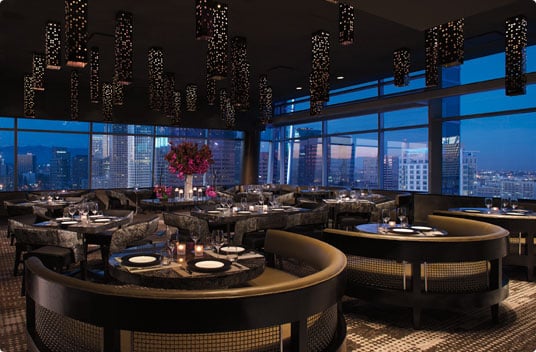
The quality spectrum for Chinese Restaurants is a wide one. If you’re the owner of a Chinese restaurant or placed in charge of interior design and decorations, the good news is that you have a lot to work with when it comes to the style you envision.
On one hand, Chinese restaurants have been voted as having the best food which customers most likely cannot get anywhere else, the unique flavors, the freshest vegetables and meat, awesome dishes and recipes you have never heard of—this is what makes it so popular.
However, depending on the spectrum that you’re going to be going for, you also might get into the cheaper side of Chinese food—the cop-out of the messy, fast food failures that will get you some noodles on a good day—or drunken food on your worst.
You have to decide from the beginning on what kind of Chinese restaurant you want your establishment to be.
To help you establish a brand and a voice, here are a few factors to consider for an outstanding Chinese restaurant:
The restaurant is in the right neighborhood.
A Chinese restaurant can really bring in the revenue if situated in the middle of a Chinese community.
Not only because the staff and owners will be included as part of that community, but also because of the
fact that you really will be situating your restaurant in a place where a good Chinese cuisine eatery will be a demand—the profits will pay for themselves!
The food you serve is regional.
As we mentioned early, you want to get as authentic as possible with the food you offer and the various options
on your menu.
The idea behind an authentic restaurant is to transport your customers to that host country, from the atmosphere, yes, but most importantly—from the food.
Before you design your menu, make sure to keep in mind that China is made of eight cookery regions:
Zhejiang (1), Jiangsu (2), and Cantonese (3)—which are recognized for their sweet and light dishes.
Sichuan (4), which covers the spiciest food in the nation.
Hunan (5), which specializes in cour and spicy recipes.
Shandong (6), which focuses on seafood.
Anhui (7) and Fujian (8), which specialize in mountain ingredients.
As the owner or head chef in a Chinese restaurant, giving your customers experience from all eight of these
regions will—quite literally—put you on the map for who you are as a restaurant.
If a customer, looking for a true, authentic experience, can find a restaurant that shows any or all of these, they have found a place where the chefs know what they are doing—and it’ll keep them coming back for more.
Understanding the regions well also gives you the idea of what is best to place on your menu.
The staff speaks Chinese.
Although not one hundred percent is necessary, it’s always a great idea to have someone—at least one person
on staff—that can speak the language of the locals.
As a guest, you’re more likely to think it as a good indicator if the staffs speak Chinese.
There is a presence of an authentic shrine of some sort.
The statues around or the pictures don’t necessarily have to be religiously symbolic in nature, however,
when it comes to Chinese restaurants, a shrine is believed to protect its inhabitants—which means they truly
want to take care of the customer.
Their menus are also available in Chinese/mandarin.
A confidently established Chinese restaurant should have a Chinese menu available to cater to the
Chinese clientele.
Therefore, if you land yourself in a place where there is both a Chinese or an English menu available,
just know that you are in the right place.
Restaurant Design and Interior Layout
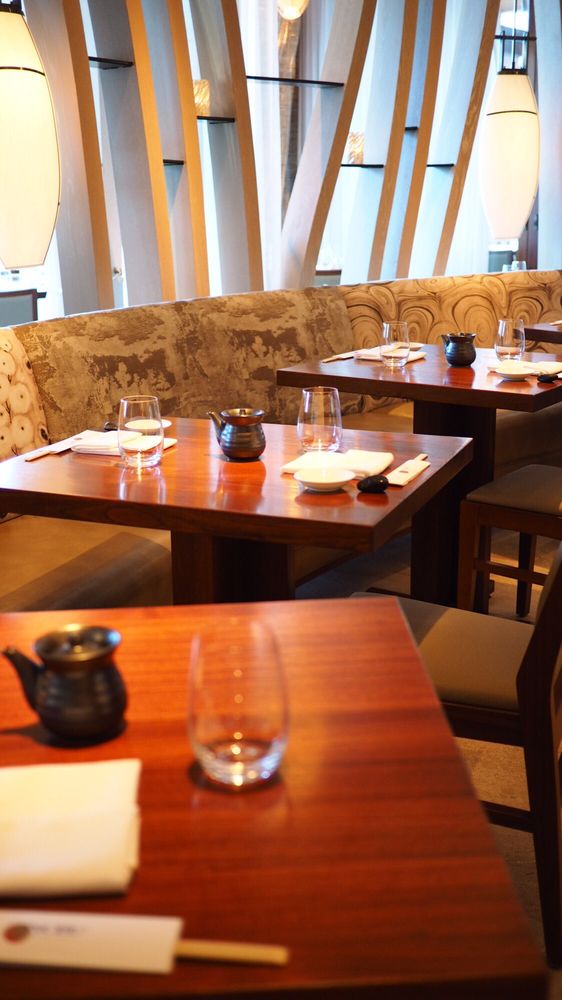
Yes, great customer service and good food are vital for good returns in business but a restaurant with a good ambiance is also important.
The true goal of a restaurant is to give an unforgettable eating experience to the customer—after all, they didn’t just come for the food (or else they might as well have just gone shopping for a quick meal).
All guests should enjoy the meals and be comfortable in your restaurant—and your decor and interior design can help give customers the all-encompassing dining experience.
However, some restaurants do not focus on interior designing but rather on the seating capacity.
To help you not “be that guy”, here are a few tips when it comes to design and interior layout:

- Balancing seating capacity: Restaurant design should strike a balance between maximum seating capacity and a welcoming ambiance.
The design of the layout should show that you want enough customers to turn a profit but still be able to make guests feel relaxed. However, some people will go for the seating capacity rather than interior design.
- Design Problem Areas: There would be no such thing as a bad table in a perfect restaurant.
However, “problem areas”—or places that most guests would rather not be seated at—exist in most restaurants,
no matter how luxurious.
These areas often include tables near the front entrance, near the kitchen entrance, and the restrooms.
To help camouflage problem areas, try placing dividers such as screens, plants, or wooden partitions in between tables. Consider repositioning a waiting area at the problem area rather than a dining table.
A good way to spot a problem area before opening day is by sitting in every sit in the dining room to identify and understand where the problem could be. This is a great way to truly get into the guests’ shoes.
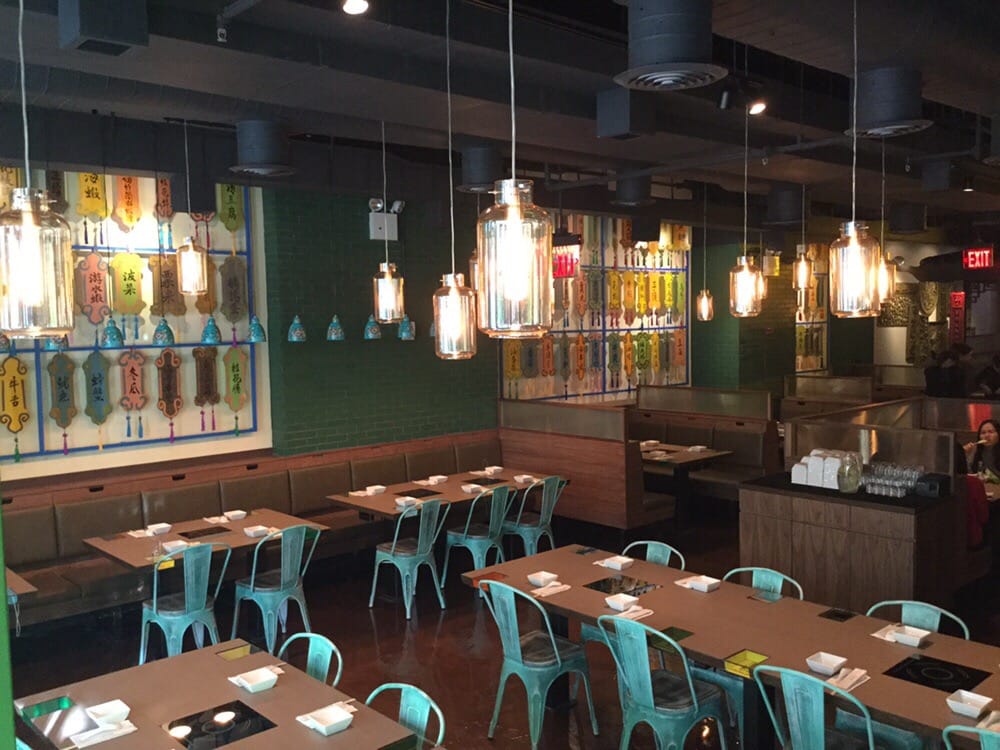
- Music: Silence is not a golden rule in many restaurants. Music can be as influential to the experience as the food itself. Normally, music and background noise can set the tone just as the artwork on the walls and the type of the menu.
Try to avoid CDs that are repetitive—especially for returning customers or those dining for a long time at once. Instead, consider a radio, online playlist or book live performances—which might be a bit expensive—but it does add a definite ambiance to the restaurant.
Most restaurants bring in live music during the weekends or specific nights of the week.
- Heating and ventilation: It is good to ensure your restaurant has good ventilation because the food, people, and work area pours out a lot of heat, smoke, and a variety of different smells.
Poorly conditioned rooms during summer heatwaves will definitely turn people away faster and this will cost you sales.
- Restrooms: Although you might not think twice about the bathrooms, ambiance and design are also carried through and to them, as well. You want to make the full experience of your customers’ time there a pleasant one.
Your restroom areas should be checked often when the restaurant is busy. Assign staff members to take out trash and refill the paper products.
What to include complementing a Chinese Eating Experience
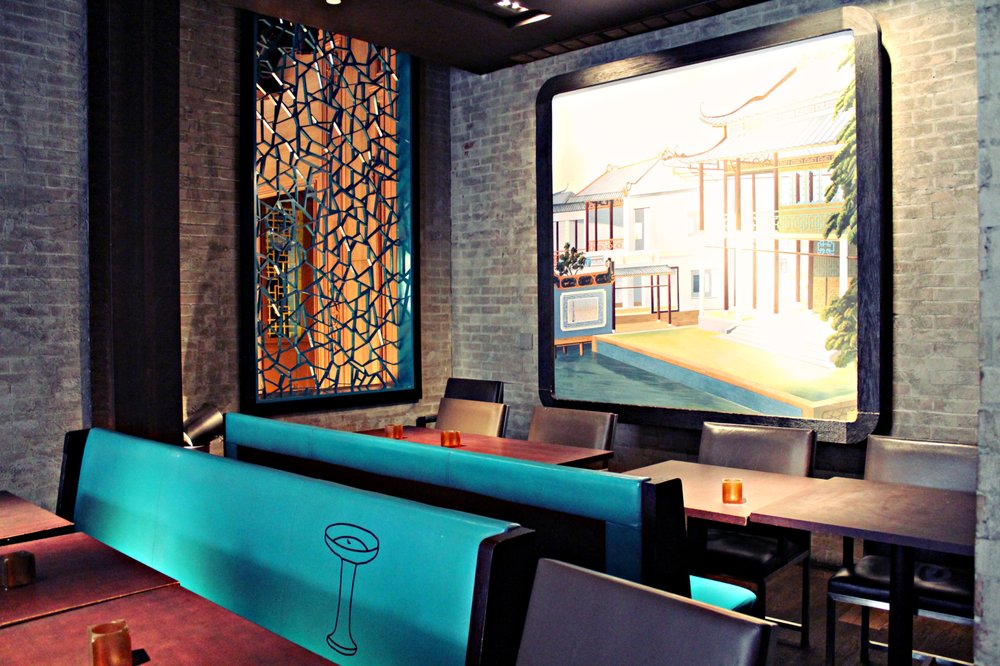
To bring a complete Chinese experience in a restaurant, here are a few examples of successful Chinese restaurants with splendid interiors from around the world:
A New York firm, New Practice Studio designed a Chinese Restaurant (Atlas Kitchen) with quirky illustrations and natural hues in Manhattan by artist Qiu Anxiong.
The restaurant was divided into the main dining room, kitchen, private nook, and communal area.
Cream walls, pops of teal, light wood ceiling and grey tile floors were featured in the eatery.
At the focal point, illustrated Chinese ink wash on plaster combined with mythical Chinese texts having present designs that join modern and ancient days.
The artist took inspiration from the mythical tales of early Chinese civilization to reconnect China’s association with modernity. The collaboration effort draws inspiration from ancient texts showcasing flavors from the eight regions of China.
Lukstudio, based in Shanghai, reinterpreted a traditional Chinese food drying rack with the structure of a metal grid and wires hanging for a noodle bar in Changsha.
The intention of Lukstudio was to develop a journey of discovery to respond to the changing of peoples’ expectations of a noodle joint.
Metal wires are suspended from the ceiling of the dining area and lighting hangs in between loops to bring the feeling of fine dining beneath a noodle rack. This design gave the restaurant a Chinese ambiance.
John Anthony Restaurant is a British tea hall turned to a Chinese canteen by Linehouse.
The restaurant is named after John Anthony, the first Chinese to be considered a British citizen in 1805.
In the restaurant’s interior, the blending of the colonial design and Chinese canteen is displayed in the details of timber bar with wicker timber, glass vitrines, and maroon and gold floral fabrics. These designs mimicked the China art-deco era of their most-used colors.
Genshang’s Shanghai Restaurant was designed by a local firm known as the Office Coastline.
The restaurant’s façade is framed by copper panels, which stand out when compared with the shopping center’s grey stone concourse and walls.
Canadian studio Sarah Ward Interiors looked to the art-deco era of China for colors and motifs with their dim sum restaurant.
Their deco was the same as the traditional Chinese motifs used to create an improved style.
Throughout the restaurant, shades of teal are found to complement the era. Although it is modern in design, the gated was made using traditional dowels and was built completely by hand.
Chinese is among the most known cuisines in the world and other than food, restaurant feature different interiors ranging from traditional to modern.
Although these are all examples of a Chinese restaurant, you can simply draw inspiration from them—you’re not forced to make them your own.
Factors to consider when decorating a Chinese restaurant
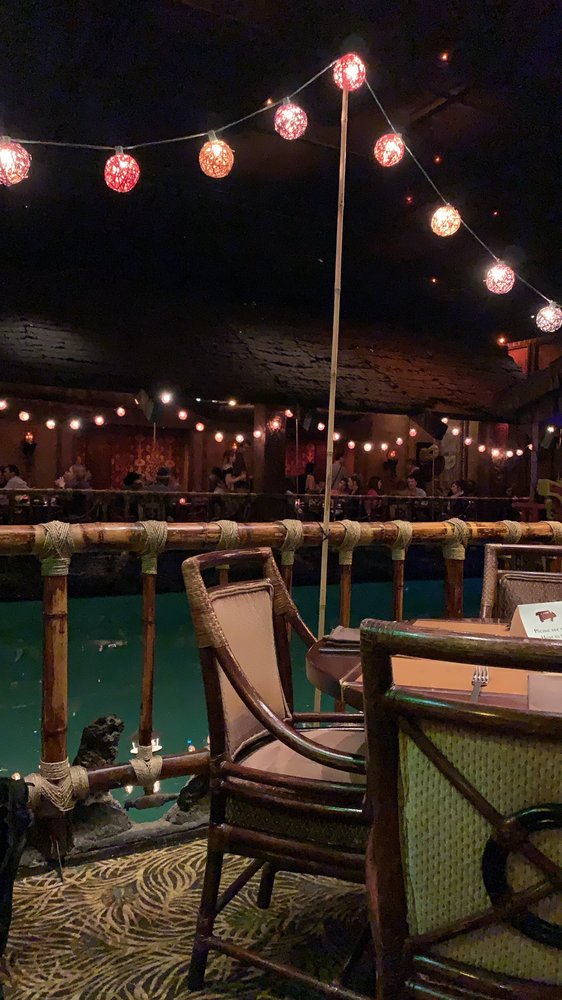
Once you have the perfect location for your restaurant, it is time to furnish and decorate it in the way it will make your customers will enjoy their stay with.
You should decorate your restaurant not just because you have knowledge of architecture or a good taste in design but also from a marketing standpoint and having the sense to use the space you have to achieve sales and promote your restaurant.
Successful Chinese restaurants make people truly feel like they’re in China because their owners have invested in making their restaurant décor look authentic. Whether the staff is dressed in traditional clothing or if you want to make it a more high-end place is up to you.
However, aside from the costumes and staff, the keys lie in the décor.
To help you achieve that authentic Chinese atmosphere, here are things to consider when decorating your Chinese restaurant:
- Color: Psychologists say that we are influenced greatly by color. From our thoughts to our emotions to even our appetite, the colors you choose to decorate your restaurant can make a huge difference. Color schemes are also a great opportunity to really get into the red and gold colors of the Chinese flag and draw inspiration from the color. The color you choose for your restaurant will create a psychological impact on the minds of the restaurant’s guests.
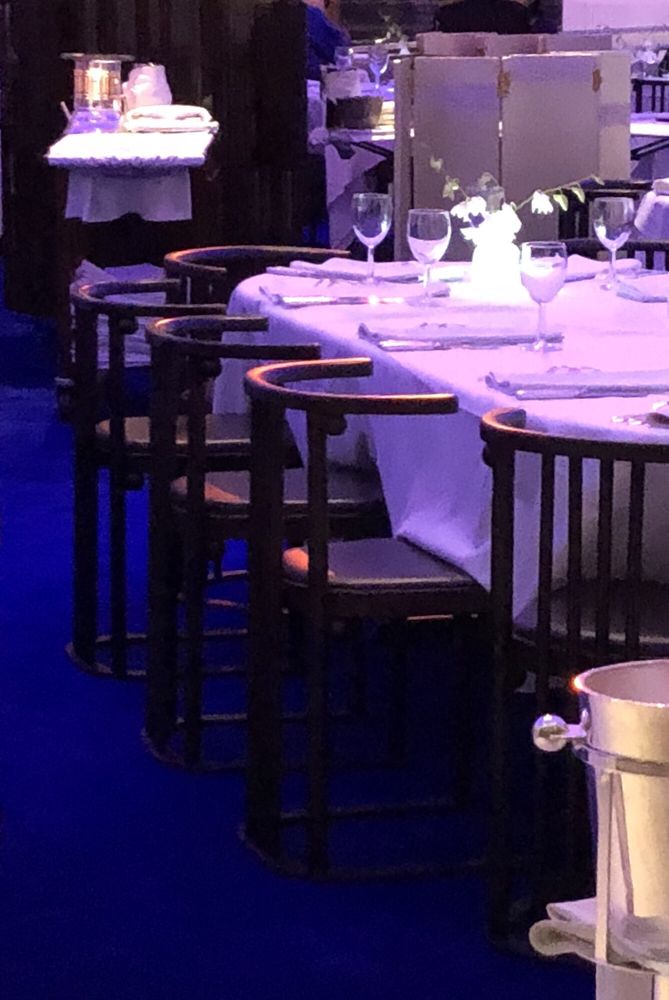
- Décor: Although you may think that most guests don’t even notice the décor around the restaurant, they take it in more than you would think. The décor plays a huge role in the guest’s eating experience—so this is a fantastic opportunity to make it work for you and developing your atmosphere.

- Lighting: In a public place, you have the opportunity to set the mood with lighting. Attractive bright lighting can give passers-by a warm welcoming appearance. When they step inside, the interior lighting could warm them with just a simple adjustment. Properly placed lights, especially at tables, encourage easy conversation among customers. The success of interior design in a restaurant relies greatly on the lighting.

- Music: As we mentioned before, music has a major effect on guests as they’re eating. Whether it’s for entertainment with a live show or background music that enhances the overall mood of both employees and guests, music can enhance appetite and improve the image of the establishment. There is a connection between food and music.
- Aroma: Aroma brings past memories of experiences and sharpens anyone’s appetite. Especially if you’re planning on selling the taste of your food—the smell plays a huge part in it. However, the smell goes beyond food and drink.
A vital element in your beverage and food marketing plan is to take into consideration the sense of smell.
- For example, a client who positioned vases of tuberoses across the dining room and this increased the number of young couples visiting the restaurant since tuberoses enhance sensuality and this resulted in a happy restaurant owner.
- Layout: You need to plan a layout that maximizes profits and increases the products’ value. Space management plays a critical role in creating both physical and psychological relationships.
- There are those areas which are most observed by customers depending on the set up of chairs tables and equipment. Therefore, instead of placing glasses or cutlery in such areas place wine bottles or sweets and a high chance of them to be purchased and appreciated rather than when they are out of customers’ sight.
- Seating capacity: You want to find that balance between getting in the adequate number of seats and the creation of a welcoming atmosphere. As the owner, you want your customers to feel at ease, you want them to be comfortably seated but still be able to make a profit.

- Kitchen design: The kitchen layout is probably the largest investment in the design of a new restaurant. A kitchen layout should be spacious enough to allow staff to serve customers adequately and promptly. You can also use your kitchen layout as an opportunity to interact with customers in a unique way.
The Must-Haves in Chinese Restaurant Interior Decorations
When it comes to decorations, the little details play such an important role—especially in a culture like the Chinese.
Some of the factors to consider before opening one are the location, the style, and the specialty of your restaurant.
Establishing a theme and style ahead of time can save you a lot of money and time redecorating until your vision is sought out.
Conclusion

If you want a restaurant that can wow customers, get first-time diners to come back after their first visit and truly transport your guests to the Chinese culture, decoration and interior design is key.
From furniture styles to what’s hanging on your walls, when you want to improve your customers’ experience, it is important to consider factors during your restaurant designing process.
There are going to be so many detailed decisions you’re going to be making—from background music to your staff’s uniforms. All these smaller details can truly help you get that effect you’re looking for, making your guests really feel the true Chinese culture.
Regardless if you’re going to be going for a fast-food Chinese style, a Chinese restaurant should still be elegant in nature, tidy in style, and enticing in the atmosphere in order for guests to get that first good impression.
This first look and feel are crucial to the success of your business. This will increase the restaurant’s attraction and enhance the guests’ appetite.
To get that right look, feel, and design you’ll want in your Chinese restaurant, Central Seating Inc. can help you with design, furniture selection, and interior decor to get you that look you’ve been wanting, to make your restaurant feel like just any tradition, corner eating establishment in China, and get your customers coming back for more.
We hope this guide has helped you with any questions or concerns you may have had in regards to the interior design and decoration of your Chinese restaurant.
Remember, when it comes to eye-catching design and fulfilling experience, you’ll want your dining establishment to be as authentic as possible. So whether you want to achieve perfect Feng Shui or if you’re following your gut, the tips on this guide can help you achieve the look and feel you want.
